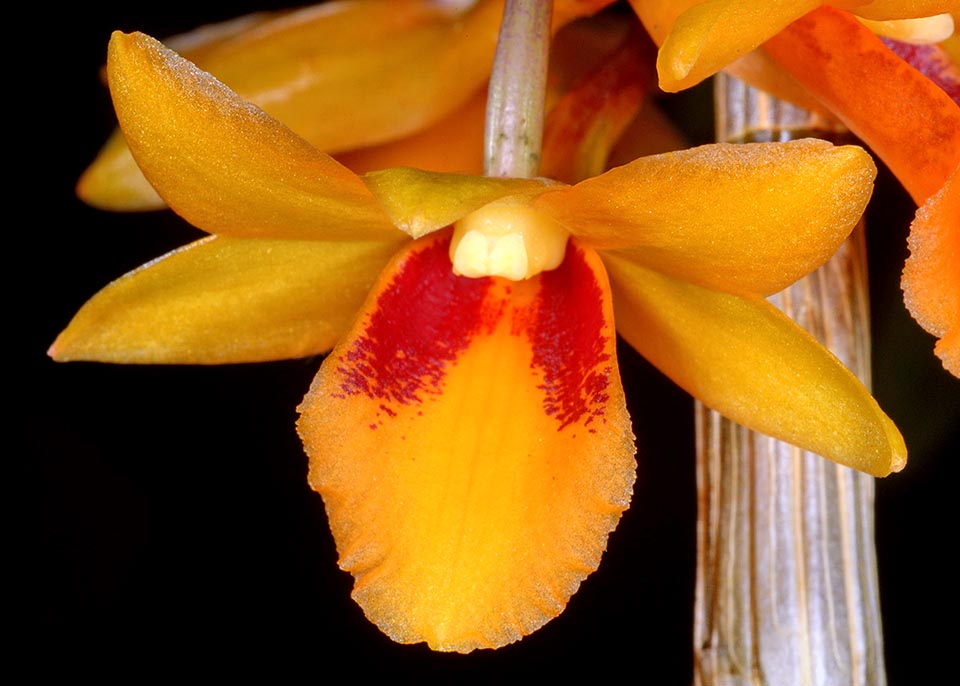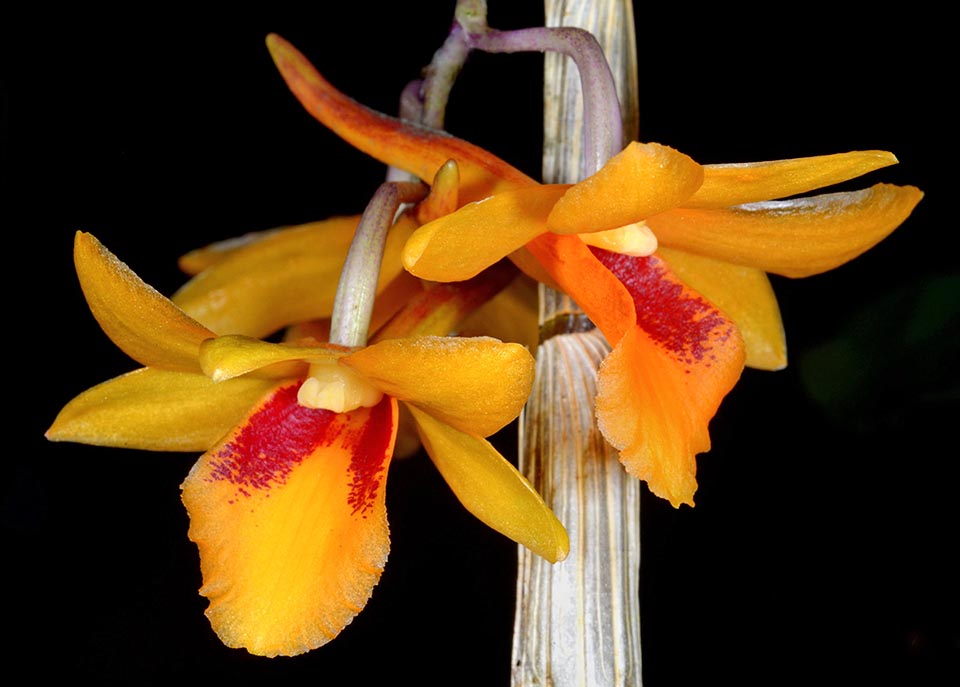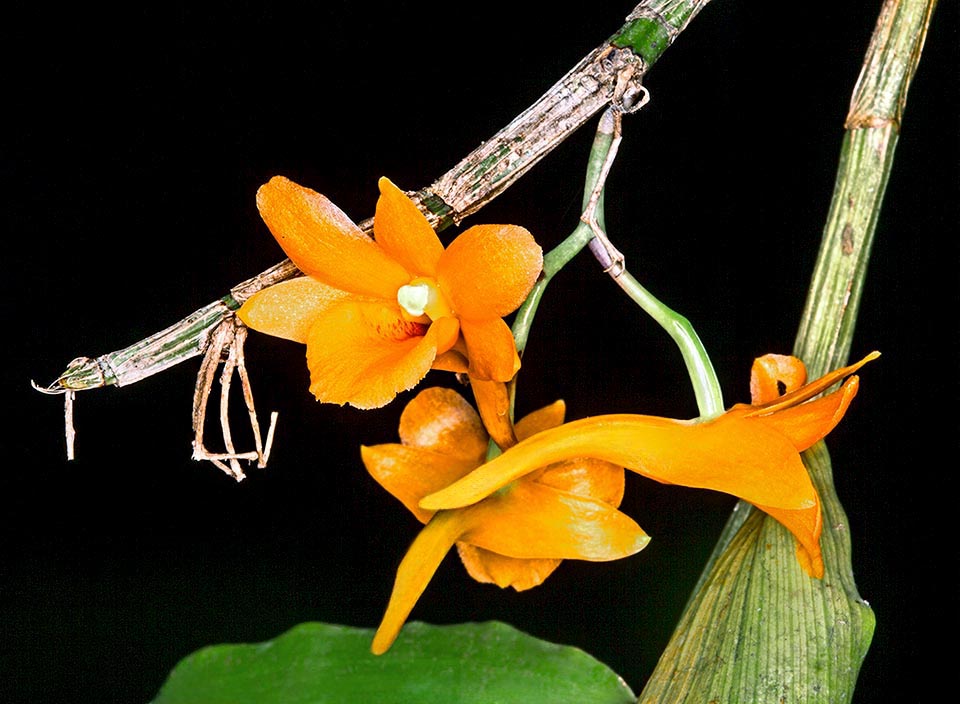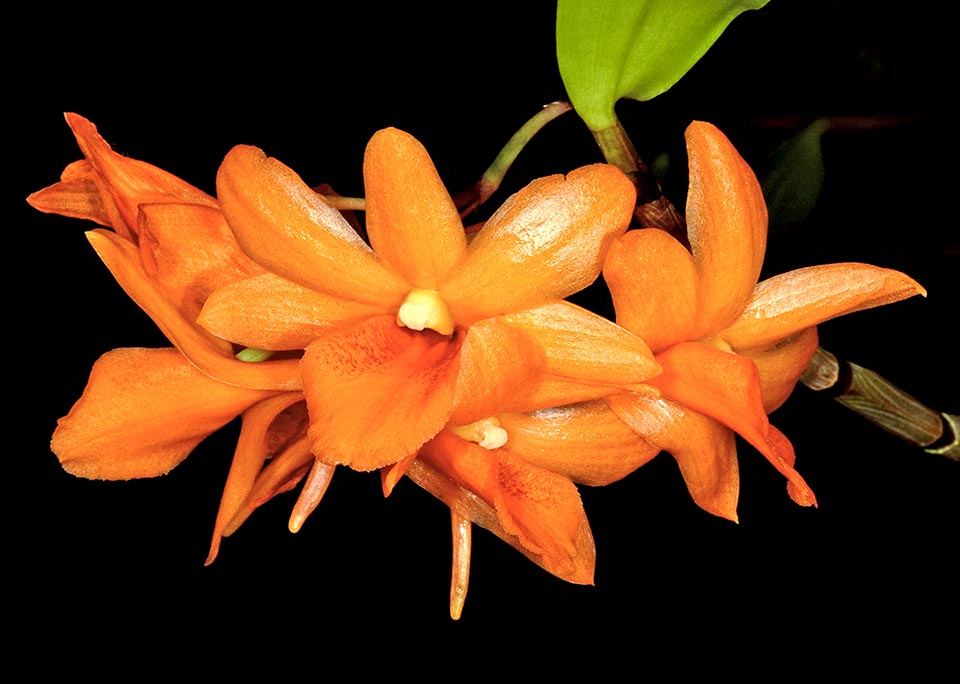Family : Orchidaceae

Text © Prof. Pietro Pavone

English translation by Mario Beltramini
Dendrobium crocatum Hook.f. is a species of the family Orchidaceae, subfamily Epidendroideae, tribe Malaxideae, subtribe Dendrobiinae, section Calcarifera.
The species was described by Joseph Dalton Hooker (1817-1911) in Flora of British India (Fl. Brit. India 6 (17): 185 1890) on specimens cultivated in the Botanic Garden of Calcutta coming from Perak (Malaysia).
In the past the range of Dendrobium crocatum, present in the lowland forest, especially along the rivers, was limited to the peninsular Malaysia and to the southern part of Thailand, but in March 2010 the botanist Destario Metusala has found several living specimens of this species in Indonesia and precisely in the plain forest of Siberut island located 150 west from Sumatra and separated from it by the Mentawai Strait (Berk, Penel, Hayati Edisi Khusus: 5A pp. 49-52, 2011). To date have not been found specimens of Dendrobium crocatum, in the nearby Sumatra, but only two similar species: Dendrobium ventrilabium J.J.Sm. and Dendrobium lampongense J.J.Sm, even if this large island is known as the speciation center of the section Calcarifera, where 29 species are known, 20 of which endemic.

Dendrobium crocatum is an epiphyte with splendid pale yellow or orange waxy flowers, with the labellum pointed of purple red, especially near the base © Ron Parsons
The morphology of the Siberut specimens is quite similar to that of the Malaysian ones, only a slight difference is noted in the colour of the flowers that are brighter and clearer.
The name of the genus is the combination of the Greek substantives “δένδρον” (dendron), tree and “βίος” (bios), life, due to the numerous species of the genus living on the trees feeding on the atmospheric humidity, typical to the equatorial forests. The specific epithet comes from the Latin “crocatum”, saffron colour, because of the colour of the flower.
Common name: Saffron yellow dendrobium.
Dendrobium crocatum is an epiphytic herbaceous species with creeping and branched rhizome. The stems, narrowed at the not tuberous base, are up to 60 (90) cm long, expanded, erect to arcuate, not ramified, with 3-3,5 cm long internodes, of the diameter of 0,3-0,4 cm, green when young, dark with longitudinal grooves when ripe.

Yore they thought that its range was limited to peninsular Malaysia and to southern part of Thailand, but they discovered that it is present also in Indonesia © Ron Parsons
The leaves are alternate, deciduous, 5-10 x 2-2,5 cm, elliptical to lanceolate that get pointed at the unequally bilobed apex. The margins are slightly wavy, with the median vein prominent on the abaxial surface. At the base the sheaths are 2,5-3,2 cm long and the petiole is strictly wrapping, cylindrical, green turning to dirty white, persistent.
The inflorescence is a 2,5-5 cm raceme, pendulous, that originates from the nodes at the apex of the stm without leaves and bears 2 to 4 flowers. The flowers of the inflorescence are facing outwards in all directions and have an about 1,5 cm long peduncle, of purple red colour. The bracts of the flowers are ovate, 2,5-3 mm long. The flowers, 4,4-5 cm long, 2,2-2,4 cm broad, are waxy, of pale yellow to orange colour, with the dorsal sepal and the petals streaked with purple red on the outer surface. The projection (mentum) is suffused with purple red, mainly close to the apex.
The labellum, widely canaliculated, is of pale orange colour, with red stipples close to the base of the median lobe. The column is robust (0,5 x 0,5 cm), white with the hood of the anther of cream colour. The ovary with the pedicel is 1,3-1,4 cm long and has a cream green colour with red purple streaks. The dorsal sepal is sub-erect (1,6-1,7 x 0,7-0,8 cm), of ovate shape with entire margins and obtuse apex.

The inflorescence is a pendulous raceme that forms from the nodes at the apex of the stem without leaves and bears 2 to 4 4,4-5 cm long and 2,2-2,4 cm broad flowers © Giuseppe Mazza
The lateral sepals, distanced from each other, are about 3 cm long, with the free part of 1,6-1,7 x 0,7 cm, oblong, whose distal half gets thinner towards the apex. The basal portion is 1,5-1,6 cm long, slightly falcate, with the outer margins fused under the labellum forming a mentum, almost perpendicular to the ovary, 3-5 cm long, cylindrical with well distinguished “S” shaped crest and obtuse and slightly compressed apex. The labellum is placed against the foot of the column with the median lobe horizontal and a long claw at the base, 4,5-4,7 cm long. The claw is fused with the foot of the column. The 0,3 x 0,2 cm anther is cucullated, that is having the shape of a hood, almost spherical with two pairs of polynodes, 1,5 mm long, shaped like a comma, yellow. The single flowers last 4 to 6 days.
Blooming takes place in autumn that, at times, may prolong up to spring. In the cultivation of the Botanical Garden of Purwodadi (East Java) a blooming has been reported in late spring.
Dendrobium crocatum is a species inserted in the Appendix II of Washington Convention (CITES), but nowadays there are no trade suspensions for this species.
Several cultivars of Dendrobium crocatum do exist.

Various cultivars do exist. It can grow in a draining pot utilizing a standard loam with sphagnum moss or bark of fir at temperatures between 16 and 32 °C © Ron Parsons
Dendrobium crocatum ‘Sundance’, presented in 2000 by Joe & Rosalie Dixler at the Chicago Judging Center, Glencoe (Illinois) where has obtained by the American Orchid Society (AOS) the CBR (Certificate of Botanical Recognition) award because judged rare and uncommon.
Dendrobium crocatum ‘Emily’s Choice’ presented in 2016 by Linda Horton at Dallas Center Monthly Judging, Garland Senior Center where has gotten the HCC (Highly Commended Certificate) certificated by the AOS.
In cultivation Dendrobium crocatum requires warm temperatures (16-32 °C) and can grow in a draining pot utilizing a standard loam with sphagnum moss or fir bark. It is a good thing to ensure a good air circulation to the roots and an intensity of light of 50-70%. The exposure to direct sunlight is to be avoided.
During the growth season the plant is to be maintained humid and well fertilized, whilst in winter the quantity of water must be reduced until the appearance of the new buds. It is susceptible to the mites attacks that may cause the fall of the leaves.
Synonyms: Callista crocata (Hook.f.) Kuntze; Eurycaulis crocatus (Hook.f.) M.A.Clem.; Pedilonum crocatum (Hook.f.) Brieger; Dendrobium pyropum Ridl.; Pedilonum pyropum (Ridl.) Rauschert.
